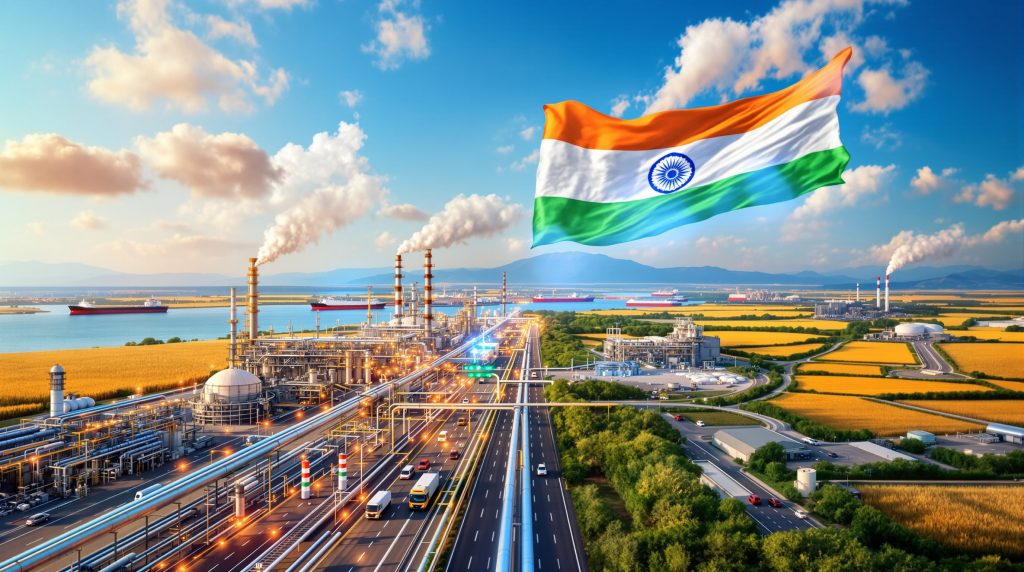Understanding India's Administered Price Mechanism for Natural Gas
India's natural gas sector operates under a sophisticated regulatory framework where the government establishes ceiling prices for domestically produced gas through the Administered Price Mechanism (APM). This system creates a structured approach to energy pricing that balances commercial viability for state-controlled producers with affordable access for essential sectors across the economy.
The APM framework applies specifically to conventional gas fields operated by state-controlled upstream companies, including Oil and Natural Gas Corporation Limited (ONGC) and Oil India Limited. This creates a dual pricing structure that distinguishes between government-regulated domestic production and market-based imported supplies, ensuring critical sectors maintain access to reasonably priced energy inputs.
This mechanism directly influences household cooking gas costs, compressed natural gas pricing for vehicles, fertilizer production expenses, and electricity generation costs throughout India. The pricing decisions made under this framework ripple through multiple economic sectors, affecting everything from transportation costs to food production expenses.
Price Reduction Details and Market Impact
India lowers november apm gas price adjustment brought domestic natural gas ceiling prices down to $6.55 per million British thermal units, representing a $0.20 reduction from October's $6.75/mBtu level. This 3.0% monthly decrease provides meaningful relief for gas-consuming sectors across the Indian economy.
Table: India APM Gas Price Movements (2025)
| Month | APM Ceiling Price ($/mBtu) | Monthly Change | Market Context |
|---|---|---|---|
| June 2025 | $6.41 | First reduction in 2 years | Structural adjustment |
| October 2025 | $6.75 | +5.3% increase | Market recovery |
| November 2025 | $6.55 | -3.0% decrease | Price stabilisation |
The oil-linked pricing formula calculation for November yielded $6.55/mBtu, down from $6.96/mBtu in October. This formula-based approach ties domestic gas pricing to 10% of the monthly average Indian crude basket price, creating an automatic transmission mechanism that responds to oil price movements within approximately one month.
Technical Pricing Mechanism Details
India's domestic natural gas pricing operates through a mathematically precise formula linking gas costs to crude oil movements. When crude prices decline, this creates downward pressure on natural gas pricing through the established 10% linkage ratio. The November adjustment demonstrates how this mechanism functions in practice, translating global energy market shifts into domestic price changes.
The gap between formula-calculated prices and actual APM ceiling prices reflects the government's ability to moderate extreme price movements while maintaining the underlying market-responsive framework. This provides stability for long-term planning while ensuring prices remain connected to international energy market realities.
Market Dynamics Driving Price Adjustments
Several interconnected factors influenced the government's decision to implement india lowers november apm gas price reduction, reflecting both immediate market conditions and broader economic policy objectives. Furthermore, these considerations demonstrate the complexity of energy pricing in emerging markets.
Primary Economic Considerations:
• Declining oil production patterns affecting the automatic pricing formula calculations
• Seasonal demand pattern optimisation requiring price stability during festival periods
• Industrial competitiveness concerns affecting manufacturing sector input costs
• Inflation management objectives across energy-dependent industries
• Consumer affordability maintenance for household energy expenses
Supply-Side Influences:
• Domestic production maintaining adequate supply levels despite declining output trends
• Strategic LNG import balancing reducing pressure on domestic gas allocation
• Infrastructure capacity optimisation enabling efficient nationwide distribution
• Regional energy security considerations balancing import dependency risks
The November price reduction aligns with India's comprehensive energy security strategy, ensuring domestic gas remains competitively positioned against imported alternatives while supporting critical economic sectors. However, this approach demonstrates the government's commitment to balancing producer economics with consumer protection requirements.
Production Decline Context
India's domestic natural gas production reached 2.82 billion cubic metres in September 2025, representing a 3.8% year-over-year decline. This production has been declining consistently since January 2025, when output stood at 3 billion cubic metres, indicating ongoing challenges in maintaining domestic supply levels.
The production decline reflects mature field performance characteristics across conventional gas deposits, where reservoir depletion outpaces new field development. Consequently, this trend necessitates increased reliance on LNG imports to meet domestic demand, making pricing competitiveness increasingly important for economic stability.
Direct Impact Sectors and Cost Savings
The November APM gas price reduction creates immediate benefits across multiple critical sectors of the Indian economy, with cost savings flowing through established supply chains to reach end consumers. In addition, these benefits demonstrate the interconnected nature of energy pricing decisions.
Primary Beneficiaries:
City Gas Distribution Networks:
• Household cooking gas supply chains experience direct input cost relief
• Compressed natural gas stations can offer more competitive vehicle fuel pricing
• Urban energy infrastructure costs decrease across major metropolitan areas
• Distribution margin improvements enable better service expansion
Manufacturing and Industrial Applications:
• Fertiliser production facilities gain significant feedstock cost advantages
• Power generation plants using natural gas see improved operational economics
• Chemical processing industries benefit from reduced input material expenses
• Small-scale industrial users gain competitiveness against alternative fuel sources
Consumer-Level Benefits:
• Transportation costs decrease through cheaper CNG pricing for vehicles
• Indirect food price stability via lower fertiliser production costs
• Enhanced energy affordability for residential cooking gas consumption
• Reduced utility costs for electricity generated from natural gas plants
Economic Multiplier Effects
Lower APM gas prices generate cascading economic benefits throughout India's interconnected supply chains. The $0.20/mBtu reduction translates to measurable savings in fertiliser production, where natural gas serves as both a feedstock and energy source for ammonia manufacturing processes.
For city gas distribution, the price reduction enables companies to maintain competitive CNG pricing against petrol and diesel, supporting India's cleaner transportation objectives whilst providing cost relief for vehicle owners. This is particularly significant in urban areas where CNG adoption has grown substantially over recent years.
The power generation sector benefits through improved dispatch economics for gas-fired plants, potentially reducing electricity costs for industrial consumers and supporting grid stability during peak demand periods.
Domestic Production Versus Import Dependency Analysis
India faces a growing structural imbalance between declining domestic natural gas production and increasing demand across multiple sectors, necessitating strategic import management to maintain energy security. Furthermore, this balance directly impacts the effectiveness of pricing mechanisms like the APM system.
Table: India's Natural Gas Supply Balance (Recent Period)
| Supply Component | Volume | Trend | Strategic Impact |
|---|---|---|---|
| Domestic Production (Sep 2025) | 2.82 billion m³ | -3.8% YoY | Declining baseline |
| LNG Imports (Oct 2025) | 2.28 million tonnes | +8% MoM | Demand response |
| Festival Season Impact | Variable demand | +4-6% seasonal | Temporary surge |
| West India LNG Spot Price | $10.80/mBtu | Stable | Cost management |
Import Strategy and Market Balance
LNG imports have strategically increased to offset domestic production declines, with October 2025 showing 8% month-over-month growth despite being 4% lower year-over-year. This pattern demonstrates India's adaptive approach to maintaining energy security through flexible import procurement, whilst managing LNG market implications effectively.
Key Import Dynamics:
• Spot market purchases provide flexibility to respond to seasonal demand variations
• Long-term contract negotiations continue but face complications from environmental regulations
• West India delivery points maintain pricing competitiveness against domestic alternatives
• Festival season demand surges require temporary import capacity increases
The $10.80/mBtu spot LNG price for West India deliveries contrasts with the $6.55/mBtu APM domestic price, illustrating the cost advantage of domestic production when available. This price differential supports the strategic importance of maintaining domestic production levels whilst developing import infrastructure.
Production Restoration Challenges
The consistent decline in domestic production since January 2025 reflects technical challenges in mature conventional gas fields. Enhanced recovery techniques, new field development, and unconventional resource exploration represent potential solutions, but require significant investment and time to implement effectively.
Infrastructure constraints limit the ability to rapidly increase production from existing fields, whilst regulatory frameworks for unconventional gas development remain under development. These factors contribute to the ongoing reliance on import supplementation to meet growing domestic demand.
Strategic Energy Policy Implications
India's APM gas pricing decisions reflect comprehensive energy transition planning and long-term development priorities, demonstrating policy flexibility whilst maintaining market confidence across multiple stakeholder groups. Moreover, these decisions occur against a backdrop of significant global trade impact concerns.
The government's responsive pricing approach signals commitment to affordable energy access whilst supporting industrial competitiveness in an increasingly global marketplace. This balance becomes particularly important as india lowers november apm gas price demonstrates policy responsiveness to market conditions.
Investment Climate Considerations:
• Domestic exploration incentives must balance consumer protection with commercial returns
• Foreign investment in LNG infrastructure continues attracting capital despite regulatory uncertainties
• Energy security planning incorporates both domestic production enhancement and international supply diversification
• Pricing transparency supports long-term industrial planning and investment decisions
Regulatory Framework Evolution
The APM mechanism continues providing market stability through predictable monthly price adjustments based on transparent formula calculations. This approach reduces uncertainty for both producers and consumers whilst maintaining government oversight of critical energy pricing decisions.
Future Policy Directions:
• Consumer protection balanced against commercial viability requirements for state-controlled producers
• Market-based mechanisms gradually integrated with administrative pricing frameworks
• Environmental considerations increasingly influence energy pricing and development decisions
• Regional energy cooperation initiatives potentially affecting long-term supply strategies
The November price reduction demonstrates the system's responsiveness to market conditions whilst maintaining affordability objectives. However, this must be viewed alongside broader patterns of oil price stagnation affecting global energy markets.
Policy Context and Market Response
The indian government's decision to reduce APM gas prices reflects a broader commitment to maintaining energy affordability during challenging economic conditions. Industry analysts note that this marks a significant shift from earlier policies that prioritised revenue maximisation for state-controlled producers.
For instance, the reduction comes at a time when commercial LPG cylinder prices have also been adjusted downward across major metropolitan areas. Commercial LPG prices saw reductions of up to ₹6.50 in November 2025, demonstrating coordinated energy pricing policy across different fuel categories.
The coordinated approach to energy pricing extends beyond natural gas to encompass broader energy security considerations. These policy adjustments demonstrate india lowers november apm gas price as part of a comprehensive strategy rather than an isolated decision.
Common Questions About India's APM Gas Pricing
How frequently does India adjust APM gas prices?
India reviews and adjusts APM gas prices monthly based on crude oil price movements and market conditions through the established formula mechanism. This ensures responsive pricing that reflects current economic realities whilst providing predictable adjustment timelines for market participants.
Which companies operate under APM pricing regulations?
State-controlled upstream companies including ONGC and Oil India Limited operate under APM pricing for their conventional gas field production. Private companies and unconventional gas producers may have different pricing arrangements, creating a dual structure in India's natural gas market.
How do APM price changes affect household energy expenses?
APM price reductions directly benefit households through lower cooking gas costs delivered via city gas distribution networks and reduced CNG prices for vehicles. The November reduction of $0.20/mBtu creates measurable savings for family energy budgets across urban India.
What role do LNG imports play in India's pricing strategy?
LNG imports provide supply flexibility and pricing competition, helping maintain market balance when domestic production fluctuates or seasonal demand increases occur. Import pricing influences the competitiveness of domestic APM prices whilst ensuring adequate supply availability.
How does the oil-linkage formula work in practice?
The domestic natural gas pricing formula calculates costs at 10% of the monthly average Indian crude basket price. When crude prices decline, this automatically reduces domestic gas pricing within approximately one month, creating responsive market linkages whilst maintaining government oversight through APM ceiling prices.
Disclaimer: This article contains information about energy market pricing and policy mechanisms that may change based on government decisions and market conditions. Readers should consult official Ministry of Petroleum & Natural Gas announcements for the most current policy information and pricing data.
Could India's Energy Price Adjustments Signal Broader Market Opportunities?
India's strategic approach to managing energy costs through administered pricing demonstrates how government policy can create ripple effects across interconnected markets and sectors. Discovery Alert's proprietary Discovery IQ model identifies similar market-moving announcements across ASX-listed energy and resource companies, helping investors capitalise on policy-driven opportunities and commodity price movements before they become widely recognised by the broader market.




